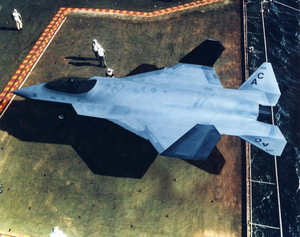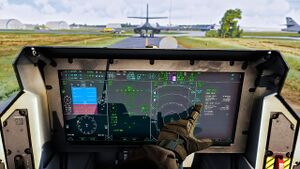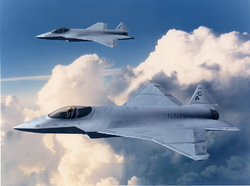Gruening F9M Osprey
| Gruening F9M Osprey | |
|---|---|

| |
| An F9M on the deck of the Marina during carrier trials in 2021. | |
| Role | Stealth aircraft Multirole fighter |
| National origin | |
| Manufacturer | Gruening Defense Aerospace |
| First flight | 14 August 2021 |
| Introduction | 17 August 2023 |
| Status | In limited service |
| Primary user | |
| Produced | 2021-present |
| Number built | 60 initial production, 10 pre-production |
| Unit cost |
86.1 million MD (F9M A)
|
The Gruening F9M Osprey is a Meridonian carrier-capable, supersonic, single engine, single seat, twin tail, stealth jet fighter, created by Gruening as a readily-available derivative of the F7M Wedgetail to respond to an urgent requirement of the Meridon Defense Forces for the acceleration of its fighter modernization program. Utilizing a large pool of common components including engines, control surfaces, avionics, weapons systems, and software, it was able to proceed from pre-production to flight testing relatively quickly.
The Osprey is oriented to provide the low-end of a high-low mix with the Wedgetail, capable of the same multi-role missionset as the Wedgetail while operating with increased operational flexibility allowed by the prior F6M Wasps, including operation from austere locations such as roadways and basically prepared runways. It is capable of utilizing the same weapons systems as the Wedgetail, including internal carriage of cruise missiles and ERIS long-range air to air missiles. Like the Wedgetail, the Osprey is a joint project between the Air Forces and the Navy. Also like the Wedgetail, it is capable of recieving both probe-and-drogue as well as boom refueling.
The Osprey was additionally designed to better suit the export market than the cutting-edge Wedgetail, and is available for export orders.
Development
Design

Operational History
Variants
Operators
Current Operators
 Meridon- 22 in service.
Meridon- 22 in service. Seuria - 20 in service before Great Marinian War.
Seuria - 20 in service before Great Marinian War.
Former Operators
Specifications (F9M)
General Characteristics
- Crew: 1
- Length: 51 ft 6 in (15.7m)
- Wingspan: 36 ft 2 in (11m)
- Height: 14 ft (4.2m)
- Wing Area: 510 sq ft (47 m2)
- Empty Weight: 28,320lb (12,487 kg)
- Max Takeoff Weight: 51,020 lb (23,142 kg)
- Powerplant: 1 × Hollon AFT11 afterburning turbofan producing 28,500lbf (military power) or 43,500lbf (afterburner)
- Fuel Capacity: 14,500lb internal, 2x optional 267gal (1,756lb/797kg) external tanks
Performance
- Maximum Speed: Mach 2.02 (2494 km/h, 1,549 mph) at altitude
- Service Ceiling: 54,000 ft (16,459) +
- Rate of Climb: 41,000 ft/min plus (208 m/s)
- Wing Loading: 100 lb/sq ft (492 kg/m2)
- Thrust/Weight: 0.85 at maximum gross weight
Armament
- Guns: 1 × Type 40 25mm cannon with 450 rounds
- Payload: 6x internal hardpoints, with option for 4x wing-mounted hardpoints, capacity of 17,000lb (7711kg)
- 4x centerline internal weapons bay hardpoints
- 2x fuselage weapons bay hardpoints for SRAAM/equivalent
- 4x optional (2x per wing) external hardpoints
Avionics
- TA-46E active electronically scanned array radar
- AE-161D radar warning reciever
- AO-62 electro-optical distributed aperture system (EO-DAS)
- AE-202 Electronic Warfare/ Defensive Electronic Countermeasures System
- AO-104 electro-optical multifunction targeting system

